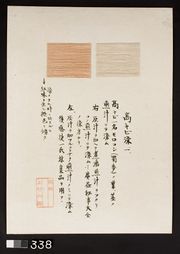Sorghum
Jump to navigation
Jump to search
Description
A cereal grass, such as Sorghum bicolor or Sorghum vulgare, with broad, cornlike leaves that are native to Africa and Asia. Sorghum has been cultivated since ancient times for its grain (couscous) and as a source of syrup (molasses). The tall, stiff, pithy stems have been and still are used for brooms and baskets. A reddish purple dye is extracted from the leaves and stems. Called guineense, it was used for dyeing Niger goatskins.
- See also [Uemera Dye Archive (Takakibi/Morokoshi)]
Synonyms and Related Terms
Sorghum bicolor; Sorghum vulgare; sorgo; broomcorn; milo; kafir; kaffir; durra; feterita; kaoliang; Sudan grass; sorghum guineense dye; Sorghum (Deut.); sorgo (Esp., It., Pol., Port.); zahina (Esp.); sorgho (Fr.); durra (Nor.);
Resources and Citations
- G.S.Brady, Materials Handbook, McGraw-Hill Book Co., New York, 1971 Comment: p. 780
- Matt Roberts, Don Etherington, Bookbinding and the Conservation of Books: a Dictionary of Descriptive Terminology, U.S. Government Printing Office, Washington DC, 1982
- Wikipedia: http://en.wikipedia.org/wiki/Sorghum (Accessed Nov. 9, 2005)
- Richard S. Lewis, Hawley's Condensed Chemical Dictionary, Van Nostrand Reinhold, New York, 10th ed., 1993
- Van Nostrand's Scientific Encyclopedia, Douglas M. Considine (ed.), Van Nostrand Reinhold, New York, 1976
- Random House, Webster's Encyclopedic Unabridged Dictionary of the English Language, Grammercy Book, New York, 1997
- The American Heritage Dictionary or Encarta, via Microsoft Bookshelf 98, Microsoft Corp., 1998

